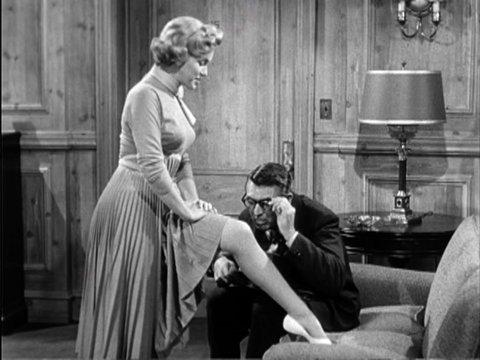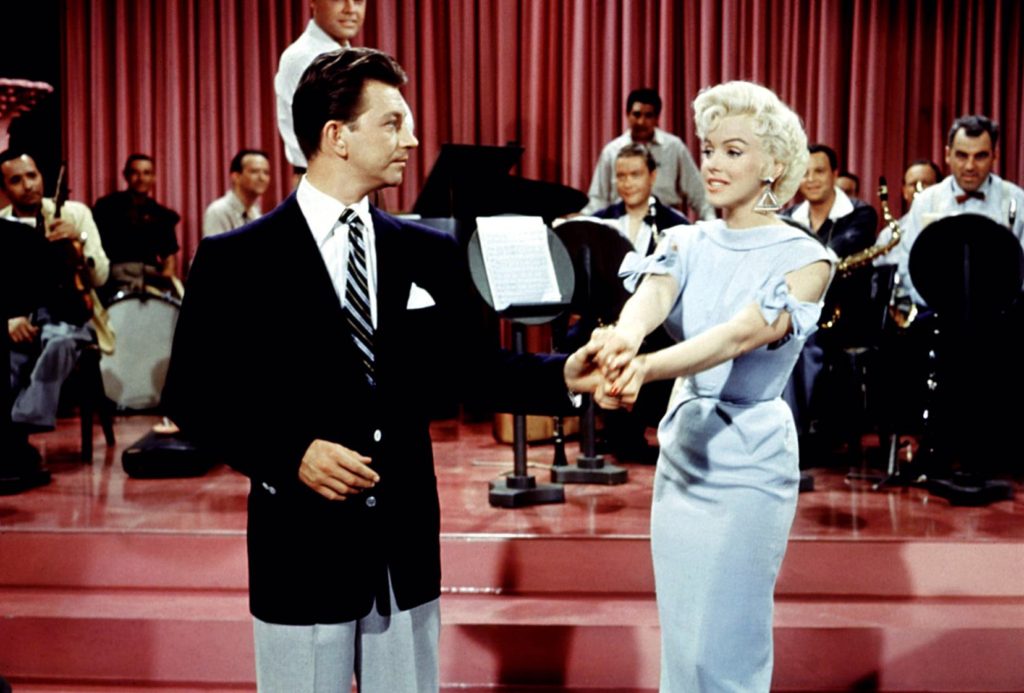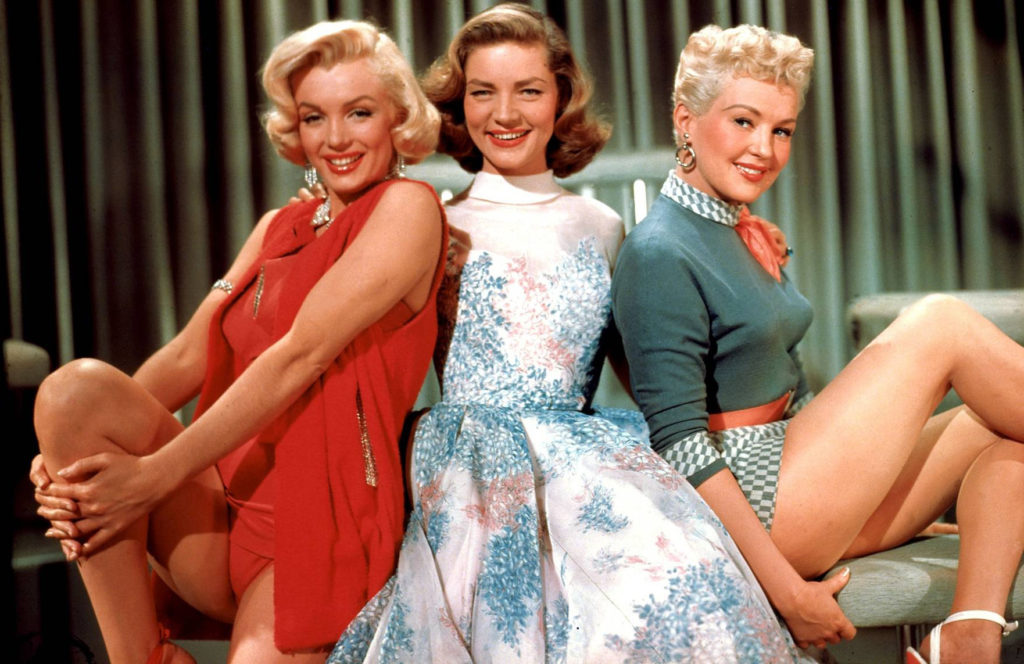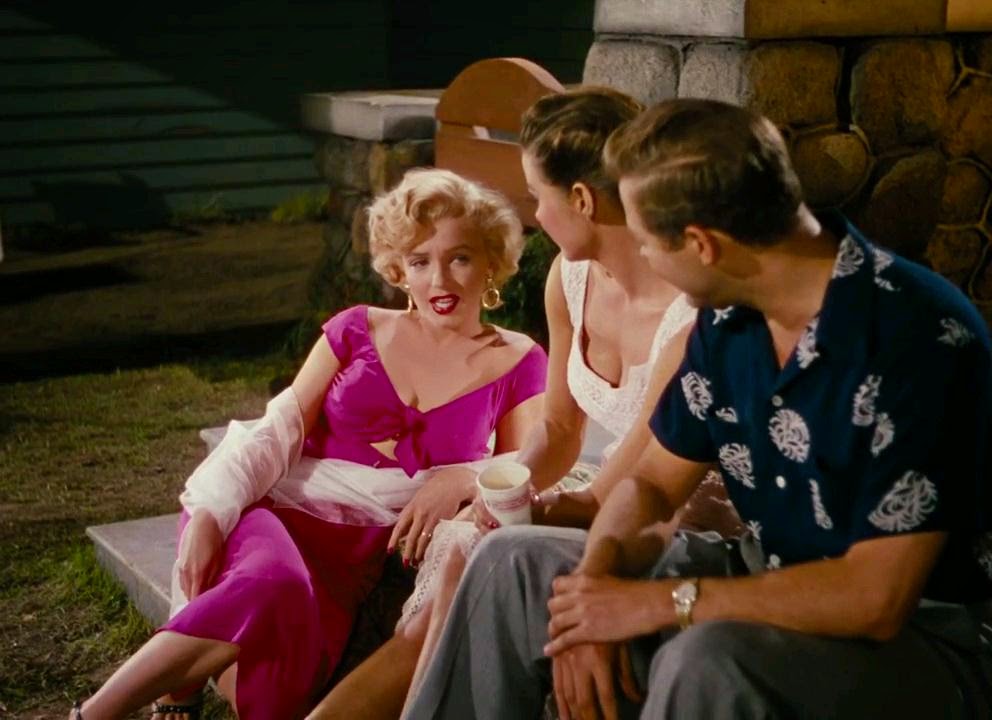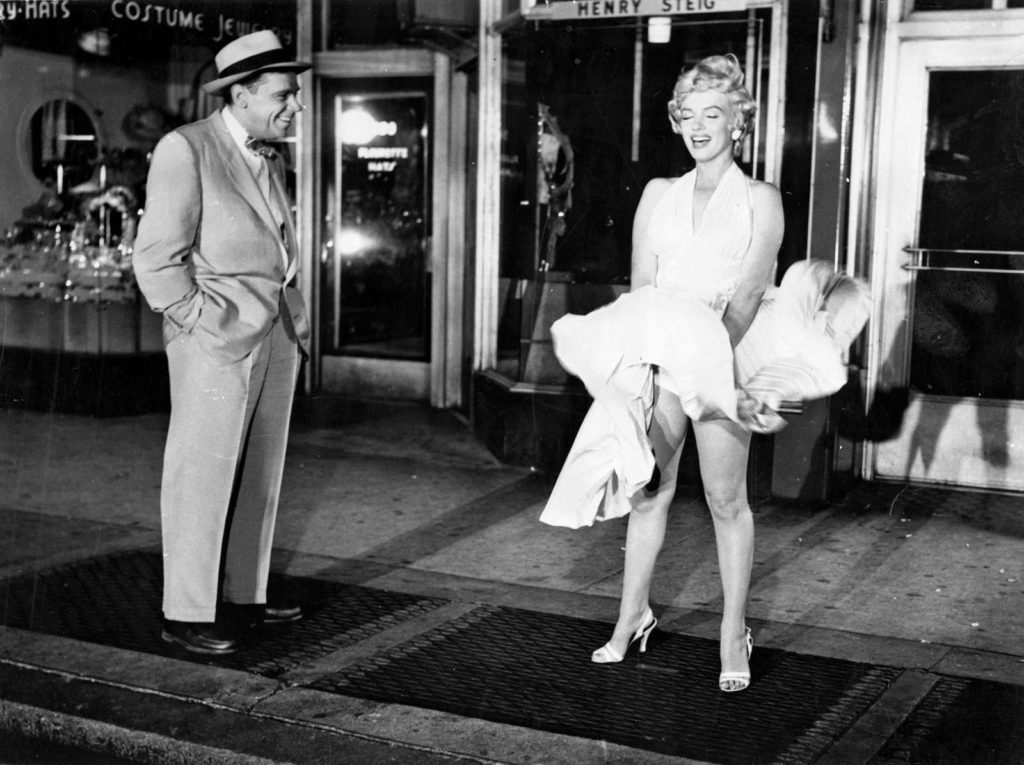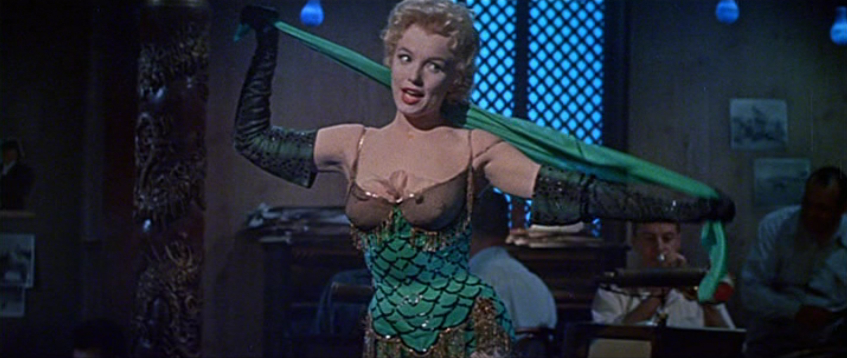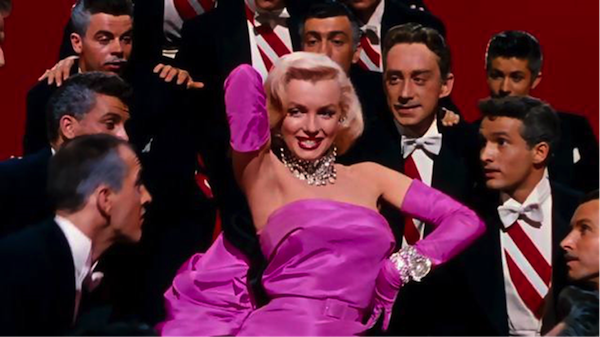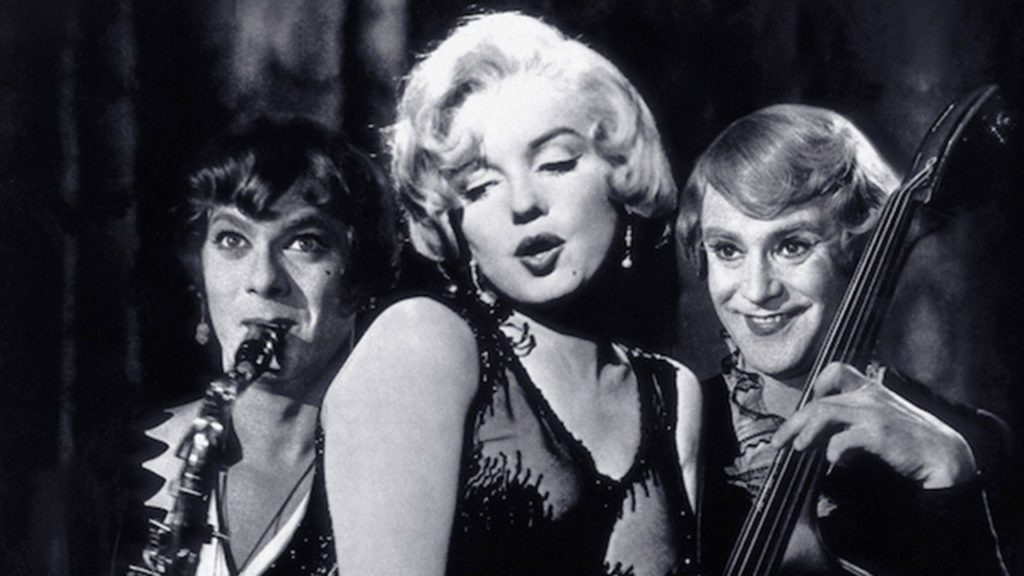We all know and love Marilyn Monroe for her larger than life beauty and iconography, but how many contemporary viewers have taken a good look at her, you know, movies? Here’s a list of musical staples, surprising dramas, and groundbreaking films that prove Monroe was more than just a pretty face.
10. Monkey Business
Cary Grant (North by Northwest) and Ginger Rogers (Top Hat) excel with wit, chemistry, self-referential charm, and adorably dry jokes in director Howard Hawks’ (Red River) 1952 screwball comedy, Monkey Business. Those unaccustomed to stereotypical fifties humor may find the rhythm both slow going and too talkative as the fountain of youth elixirs go awry, but deadpans and silent slapstick keep the preposterous premise smart. Secretary Marilyn Monroe’s clueless yet lovable steamy manner accents the hair-brained trouble despite less screen time, and the innuendo and misunderstandings she causes are as amusing as her stupidity. Monroe’s delivery is smooth nudge nudge wink wink – equal to Grant without being over the top like that obviously fake rear projector driving scenery. Although the black and white photography hides some of the sweet costumes, the laboratories and monkey moments are pretty fun. Yes, one won’t find serious science and ethical consequences in the of its time experimentation, but viewers looking for witty, sophisticated classics can delight in shenanigans here.
9. There’s No Business Like Show Business
This 1954 musical is not the How the West Was Won of musicals, as it could have been. Breezy resolutions happen too easily despite the ups and downs from Vaudeville to Broadway, and the straight Depression drama is uneven compared to the big dance numbers. However taking There’s No Business Like Show Business seriously misses the point of those great Irving Berlin (Holiday Inn) tunes. Great comedic honesty keeps the mid-century innocent fun as the two for one movie and a show provides both simple two person toe tapping, as well as full scale stage productions that don’t need extra camera tricks, editing, or zooms. Our showbiz family plies their trade while come hither coat check girl with dreams Monroe looks dynamite in sheer, barely there costumes for “After You Get What You Want You Don’t Want It” and “Heatwave.” Her dance routines are a little plain with dated dancing and it’s a lot of sexy with little room for depth, but the husky, sultry delivery is hot, hot, hot. Despite the rushed romance with Donald O’Connor (Singin’ in the Rain) and the Ethel Merman (Call Me Madam) spectacle viewers came to see, Monroe steals several catchy, unable to take your eyes off her moments. This isn’t made with dramatic character focus in mind, but the great music, stage atmosphere, and showstoppers get it right.
8. How to Marry A Millionaire
Wisecracking model Lauren Bacall (The Big Sleep), dimwitted Monroe, and funny Betty Grable (Tin Pan Alley) plan to bag millionaire husbands in this 1953 charmer. Sure it’s a silly, standard premise, but our gals measure their prospects with statuesque slapstick and winking sarcasm. Modern viewers might not get some of the older, high brow references compared to today’s idea of a reality show gold digging hussy, but the laughter and nostalgic innocence keep the ironic misunderstandings and ladies’ futility bemusing. Of course, Marilyn’s made to look ugly via some horn rimmed glasses, but her bumping into walls without them and comedic clumsiness is endearing, as well as strategically timed. Monroe’s still graceful amid the goofy dialogue and dumb questions thanks to youthful designs and classic pillbox hats, furs, and gowns. Sultry Bacall looks dynamite in Technicolor, too! The CinemaScope, colloquial slang, cigarettes, and cocktails accent the bright lights and big city whimsy, capturing this specific mid-century high life as forever young on screen.
7. All About Eve
Marilyn Monroe’s role in this much-lauded 1950 classic is small, but she holds her own amid headliners Bette Davis (Jezebel), Anne Baxter (The Ten Commandments), Supporting Actor winner George Sanders (Rebecca) and more. This young early appearance is indicative of the ageism and sexism herein, for there will always be a younger actress waiting in the wings. Oscar winning director Joseph L. Mankiewicz (Guys and Dolls) captures the cutthroat ambition, catty attitudes, latent symbolism, and us versus them curtain divides with tongue in cheek winks and play within a play stage versus Hollywood. Stars and scandals are interconnected with Dickensian favor or demise as fun name drops, freeze frame narrations, and Shakespearean asides unpack the archetypes and interplay. Contemporary audiences may not like the multiple narrators, flashback frames, or telling style, but it’s all about perspective. Where does the stage stop and reality begin and who do you trust or stab in the back to go on with the show? Sweet fashions, furs, bling, and theater dressings heighten the drama with visual jealousy while the superb script, passive aggressive wit, and on form company fasten their seat belts for this must see spectacular.
6. Niagara
Honeymooning couples, mental illness, and steamy young Mrs. Marilyn Monroe collide in this 1953 nail biter as two lovers plot to rid themselves of the older husband in the way. Unfortunately, things don’t go to according to plan despite good girl gone criminal Marilyn’s wispy delivery and tight, hot pink, low-cut dresses. Granted, there’s a certain amount of that Golden Hollywood overacting, but Monroe’s brash matches Joseph Cotten’s (Duel in the Sun) heavy in this saucy departure from those funny singing, dancing sweetie pies. We can’t look away from her swaying hips whenever she’s on screen, as the sex goddess status is cemented alongside the captured in time changing natural wonder of the titular Falls themselves. Though perhaps the secrets are obvious to wise thriller viewers today, the loveless marriage and murderous plot aren’t as important as the getting there thanks to the lavish Technicolor, red lipstick, and true blue murderous waters. Skillful lighting and foreboding music elevate the sense of noir danger – keeping young and old on the tantalizing edge.
5. Don’t Bother to Knock
Hotel lounge singer Anne Bancroft (The Miracle Worker) breaks up with wayward pilot Richard Widmark (Kiss of Death), so he flirts with standoffish babysitter Marilyn Monroe in this 1952 black and white melodrama. Past issues, death, suicide, abuse, and institutions toe the Hollywood Code, contrasting the should be wholesome two beds and marriage goals as our sitter tries on the lady’s negligee, steals jewelry, invites men over for a drink, and puts her charge in serious jeopardy. If told today, this would be overlong and nastier, without room for all the subtext, speculation, innuendo, latent kinky, and voyeuristic tones. Here Monroe is young, frumpy, immature; but mischievous and off-kilter. Her firm insistence on not eating candy but sneaking chocolate is a little creepy, even scary as she mishandles the kids. Why was Monroe not given more meaty, purely dramatic roles after this fine turn? While a little short at under eighty minutes, the real time suspense unfolds swift and smart as concurrent plots intertwine. Moody black and white photography, melancholy atmosphere, and diegetic music tie the escalating tension, nefarious, and violence together. Modern audiences looking for an intelligent thriller will enjoy the upscale suspense and crazed performances.
4. The Seven Year Itch
The iconic billowing white dress of 1955’s The Seven Year Itch may be overplayed these days – it’s certainly on enough Marilyn Monroe merchandise! However, the temptation of a neighbor like “The Girl” is almost too much for a loyal husband of seven years while his wife and son are away for the hot New York Summer. Playing chopsticks beside the air conditioner starts innocently enough, but the panties she keeps in the fridge make a man smoke a cigarette, and director Billy Wilder (The Lost Weekend) uses every camera angle to feature Monroe in all her blissfully unaware glory. Monroe is full figured with costumes to fit every curve, but it’s her marshmallow delivery and cute timing that make her so likable. Who wouldn’t want to hang out with Marilyn while eating potato chips and drinking champagne? Suggestive references, twists on fidelity, and naughty dream sequences with seductive secretaries and bedside nurses are funny, if dated with the ideal male fantasy. Here women are either dowdy homemakers or unachievable sexual beings, but compared to other terribly out of touch pillow talk films, this time capsule is as fifties quintessential as that delicious subway breeze.
3. Bus Stop
1956’s Bus Stop is a brooding examination of flawed ruffians and desperate singers, packing a psychological punch with strong arming men, reluctant ladies, kidnappings, and snowstorms. Middle of nowhere buses and diners lead to abhorrent behavior as Monroe’s Cherie tries to escape her hick roots for Hollywood. Even for its time, the men being men and stay at home little women commentary isn’t as dark or scary as it could have been, but there’s plenty of hurt for the cast to digest nonetheless. The abused hillbilly girl trying to flee her past – who would have thought this was a role meant for the glamorous Marilyn Monroe? Steamy but tragic, Cherie both wants to be a star yet doesn’t want public attention. Her accent is a little off, but Marilyn’s less than perfect rendition of her lone song “That Old Black Magic” is near weeping and off-key, and the broken lyrics work better than some of her more famous, carefully conducted show tunes. Monroe is thinner, pale, gaunt – an overworked nightclub girl stuttering in fear and ashamed of how her man treats her. How can we fault a pretty girl with dreams and desires of real love? Viewers looking for vintage charm and Monroe merit and should give Bus Stop another look.
2. Gentlemen Prefer Blondes
Even if you haven’t seen this 1953 musical co-starring Jane Russell (The Outlaw), we all know about Marilyn’s shocking pink satin dress and “Diamonds are a Girl’s Best Friend.” Our two showgirls travel to France for flirtations and husbands as handsome detectives, adorable youths, and an entire swim team mix with patty cake photos, glittering ruby frocks, and tiara bling bling. From the opening “Two Girls from Little Rock” to the famous “Diamonds,” director Howard Hawks doesn’t let up on the tongue in cheek winks for an hour and a half; be it spectacle stage numbers, quiet comedy scenes, subtle slapstick, or sarcastic asides. Rather than song after song, time is taken to make us love our ladies even more. Master of the dim blonde, Monroe matches Russell’s zingers with unaware stupidity – and getting stuck in a porthole – so we forgive her trembling at the sight of a tiara while asking, “How do you put it around your neck?” Dynamite verses and swinging tunes cater to both their ranges and dilemmas while the ship bound romances run amok and the dames strut their stuff.
1. Some Like it Hot
On the run musicians Tony Curtis (Spartacus) and Jack Lemmon (The Apartment), Marilyn Monroe’s Sugar Kane, and the all-girl band unknowingly taking in “Josephine” and “Daphne” are just a few of the reasons to love director Billy Wilder’s 1959 comedy caper, Some Like It Hot. Mobsters, drag disguises, mistaken millionaires, oil tycoon facades, and entangled romances are humorously all so innocent, yet full of both hetero and homosexual innuendo at the same time. Memorable, multi-layered dialogue works well with classy song interludes, and the fish out of water battle of the sexes mayhem is shrewdly left open to interpretation. Top-billed star and Golden Globe winner Marilyn doesn’t have as many musical numbers or dancing tunes as we’ve seen previously, and alleviating that show stopping crutch allows her ditsy skills to work wonders alongside Curtis’ champagne when not bunking in the train car with Lemmon. In spite of behind the scenes difficulties, or maybe because of them, we love her Sugar all the more. Combined with the black and white lighting schemes, Monroe’s tiny nighties and sheer frocks reveal just enough for us to imagine we saw something more scandalous, and her curvaceous sex appeal peaks in the “I Wanna Be Loved By You” serenade. The suggestive duality still works precisely because it was so then risque, and the naughty subtext essentially put the kaput on the Production Code. No film is perfect, but Some Like It Hot comes damn close.



